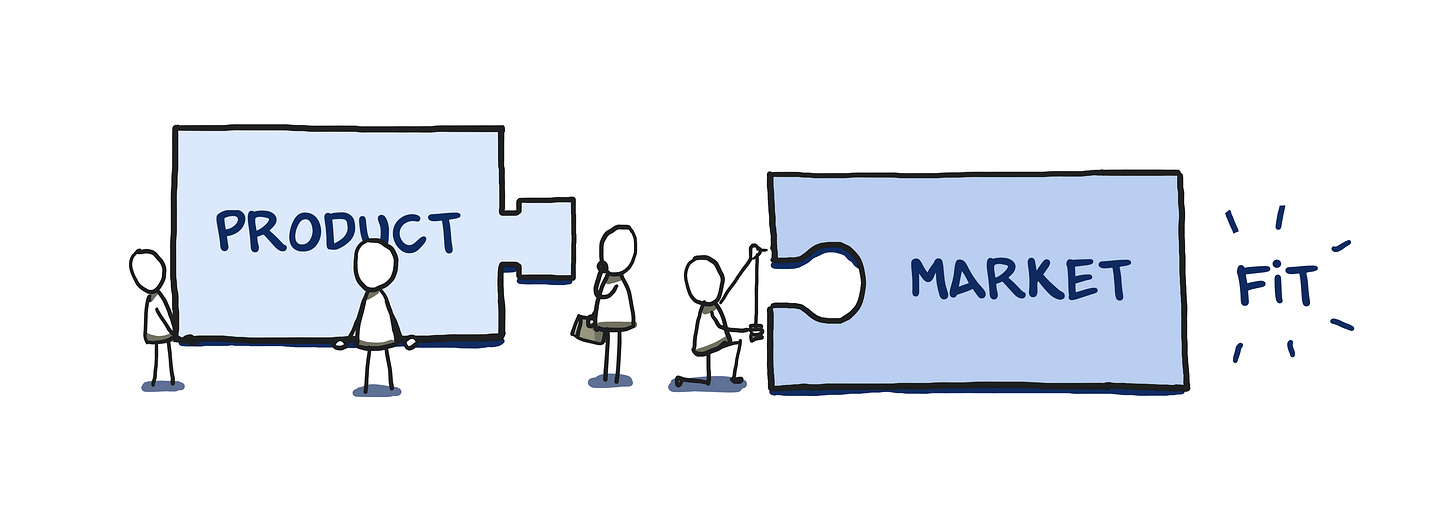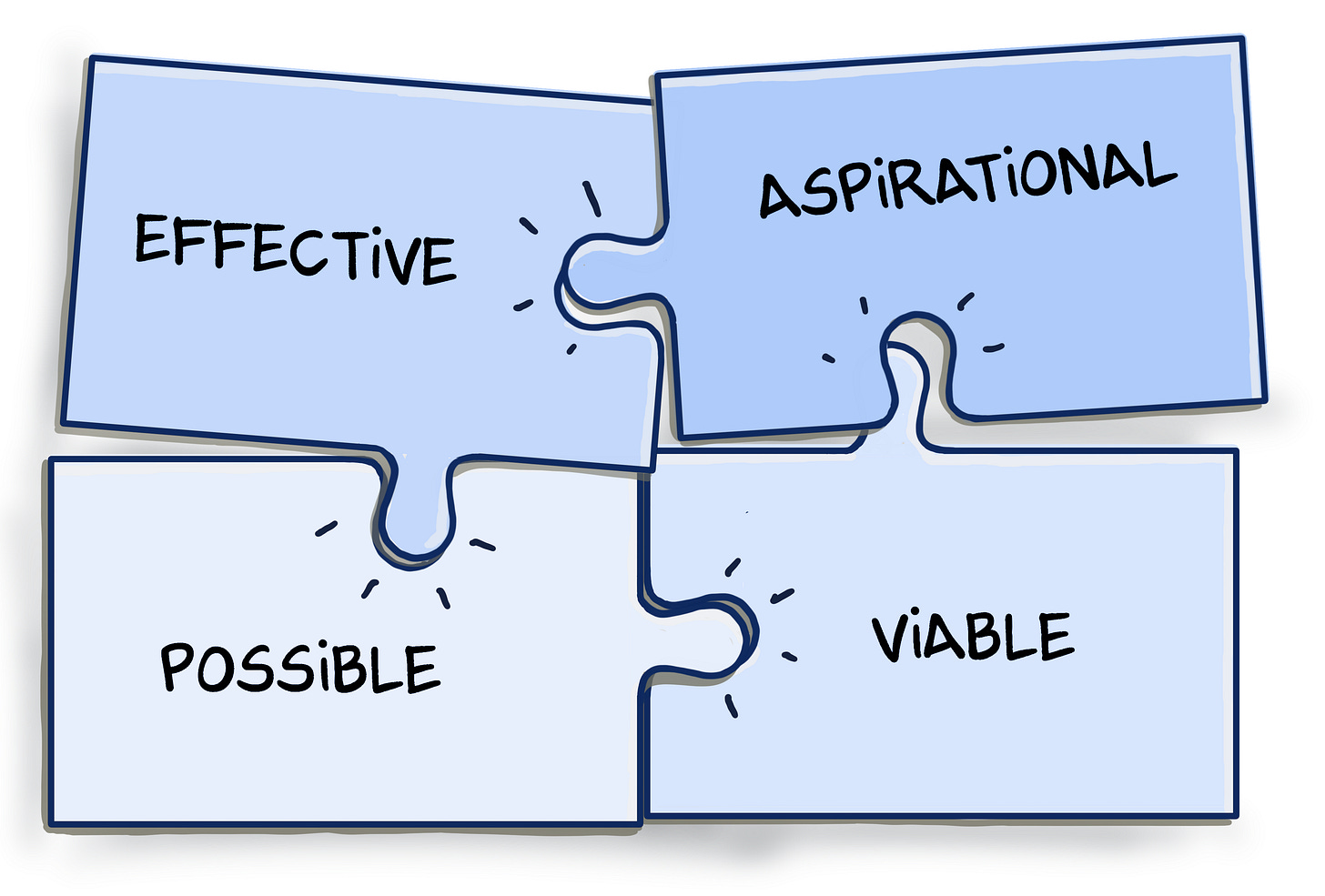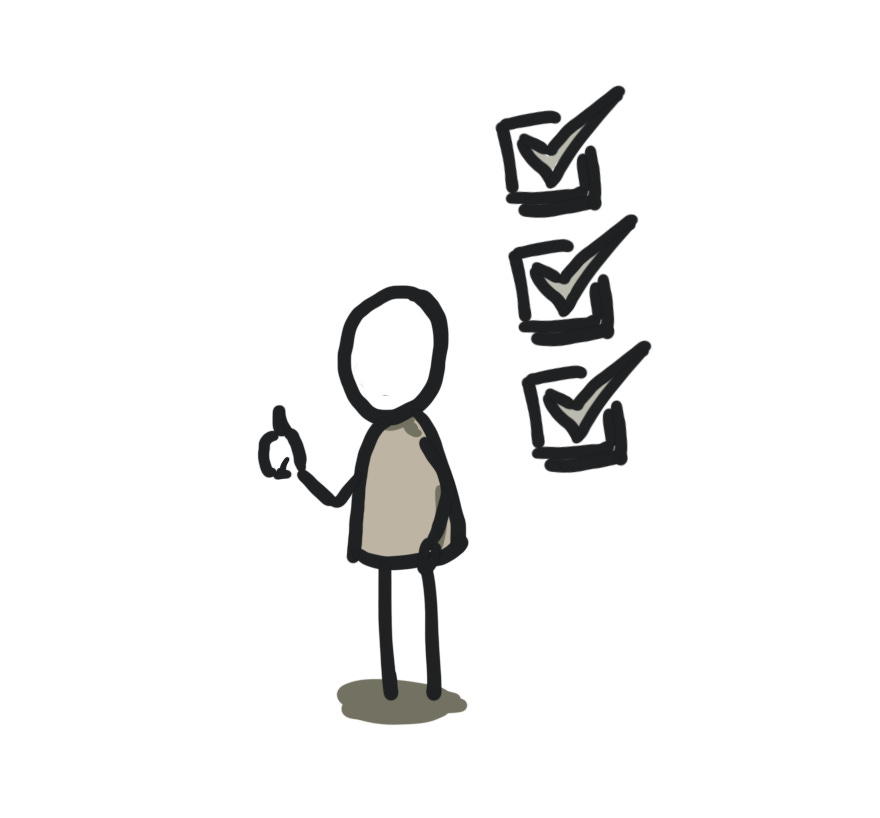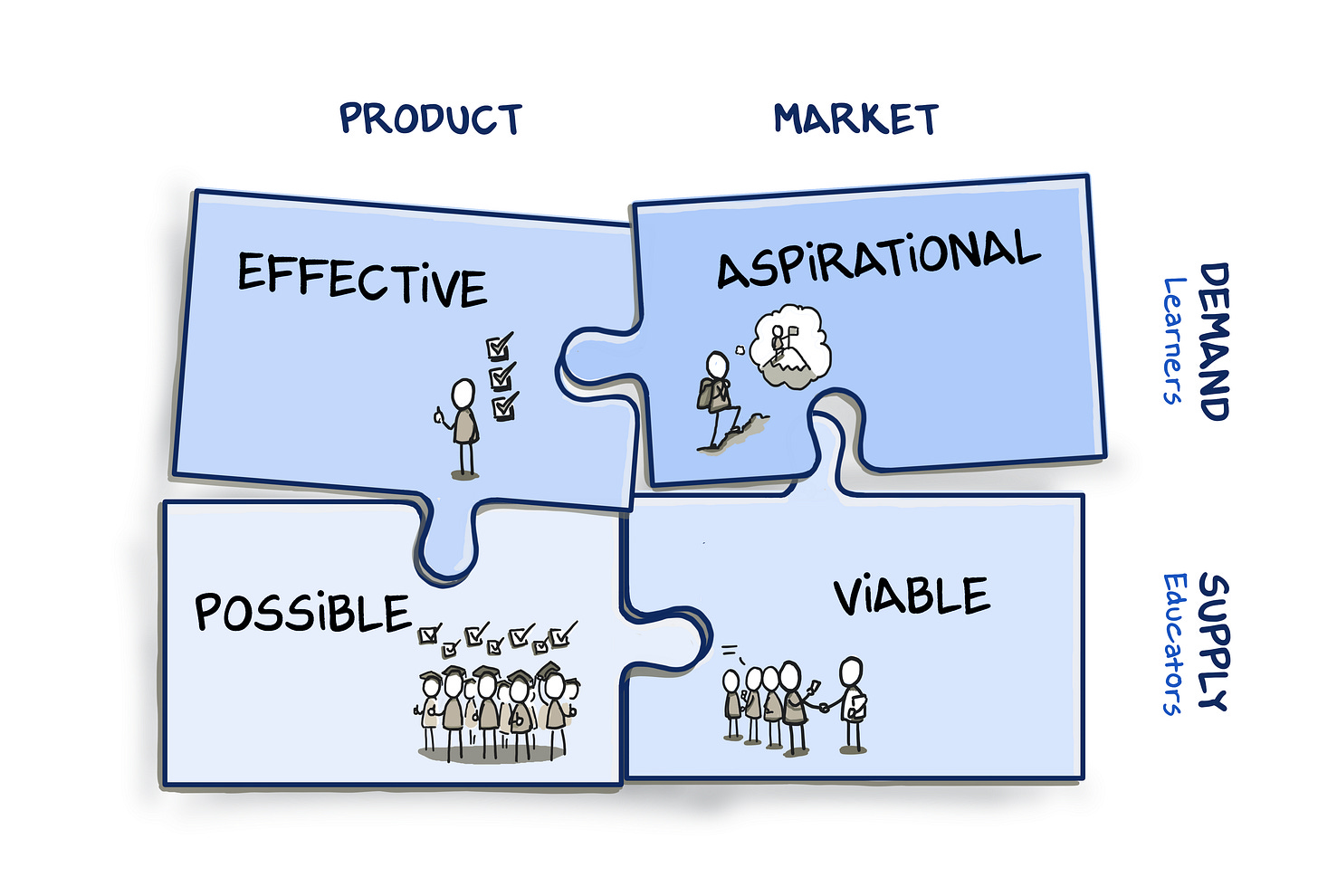Product-Market Fit for Learning 1: Dimensions
In the first of the definitive two-part guide to creating new transformative learning, the four dimensions you need to crack.
See part 2 here.
Product-Market Fit is a concept that is used as a way of understanding if a new venture is delivering value to people and if it’s worth investing more time, effort and money into.
It was originally coined by the Silicon Valley investor Marc Andressen who observed that teams building new products typically didn’t pay enough attention to the market. They obsessed about the product, but the market was often the biggest factor in if their product was successful.
Many have built on this idea and it is now accepted in the tech industry as the thing that new startups need to crack. How do you meet the underserved needs of a particular group better than the alternatives?
Whilst it originated in the world of technology startups, this approach is a useful mental model for building a broader range of new learning programmes, products and businesses.
Creating new learning products that people want, which deliver the outcomes they are looking for and are also viable businesses is really hard. Applying product methods and design thinking can dramatically increase the chances of success.
Fundamentally, it’s about taking a human-centred approach to innovation. It also takes into account the range of factors that contribute to building a successful and sustainable business, whether for a commercial return or as a non-profit.
Despite being a simple idea, the realities of finding Product-Market Fit are complex and open to interpretation. For impact products like learning, there is extra complexity in terms of efficacy and because learning is fundamentally hard work. Product-market fit often seems mysterious and like it’s a result of luck or timing.
But there are some well documented concepts and methods that can be applied to help you find it. Let’s explore those in a way that feels relevant for the business of creating transformative learning.
First let’s look at four Dimensions that you need to consider to build a successful learning product. In the next article, we’ll look at the Stages you need to work through to successfully find true product-market fit.
The Dimensions
There are four dimensions to making a successful product that can be reframed to work well for learning.
These dimensions take inspiration from the work of IDEO on business innovation, Marty Cagan’s ‘product risks’, First Round’s PMF Method and the writing of many others on product-market fit. You can find links to these at the bottom.
They are also a result of the pattern recognition I have developed through working on many new learning products through my coaching and product leader work and the case studies I’ve been collecting over the last five years. I’ll include examples of these to help bring the dimensions to life.
To create a successful learning product, you need to build something that is:
Aspirational: it meets a clear unmet need and goal.
Effective: it is practical and delivers on the outcomes.
Viable: it has a sustainable growth and business model.
Possible: you can deliver the outcomes in a scalable, repeatable and profitable way.
To find product-market fit, you need to consider all four dimensions and how they fit together. Very often products will have found success on some dimensions, but not others. Without all four, this is not true product-market fit.
Let’s take a closer look at each dimension.
1. Discover something… Aspirational
Your starting point is to identify something that people need and really want. Where are the struggles and frustrations that you could remove? What are the goals people want to achieve?
Not only that, you need to offer something they want more than the potential alternatives. If they already have a way to achieve their goal, they need to want your alternative significantly more to overcome the friction of doing something new.
Your product needs to be aspirational.
These needs and goals are not something that you can create. Instead, they are something that you have to discover.
Many learning products fail because the people creating them aren’t clear on the desired outcomes - or who it is that wants them. Often, the thinking is based on assumptions that haven’t been properly validated by spending enough time with potential users or learners.
The first step to building a transformative product is to find something that enough people care about - and care enough to pay to address it. Or at least where there are people willing to pay to address it on their behalf, something that’s common in the world of learning.
This means that your product needs to be more than just ‘nice to have’. Not just, “yeah that sounds good…” but, “I need to do this, sign me up now!” Sometimes this is referred to as seeing the magic.
For this to happen, you need to address a genuine pain point and improve their life in a meaningful way.
You need to identify:
A group of similar people
Experiencing the same needs or frustration
Looking for the same outcomes or with a similar goal
With all products, you need to focus on the motivation and outcome of your target audience. This is even more true if you’re building something in learning: what is the transformation they are hoping to achieve?
Examples of aspirational learning products
These are some examples of clear needs that learning products helped address in ways that are distinctive from the competition.
Multiverse rapidly grew by offering apprenticeships to fill growing skills gaps like data analysis and enabling employers to spend their apprenticeship levy.
Oak National Academy launched during the pandemic and enabled schools to easily deliver lessons online. They now offer an AI lesson assistant to give teachers back their Sunday nights.
Butter offers educators and facilitators a smooth way to deliver engaging online workshops without needing multiple tools and tabs.
BoClips made it easy for educational publishers to include video content in ebooks without going through the pain of clearing rights for lots of videos.
The London Interdisciplinary School offers an alternative to an MBA that equips mid-career leaders with the skills to navigate the big shifts in energy, intelligence, ecosystems, trust and longevity.
Follow the links to find out more.
Reflect: who are the people who you are serving? What is their context, need and motivation? What outcome are they looking for?
2. Make it… Effective
Once you’re clear on the people, their context and motivation, next you need a solution to help people achieve the outcomes in a practical and impactful way.
It needs to be effective.
Your product or experience needs to fit with how they live and work, in a way that is realistic and achievable for them. It needs to be ‘user friendly’ and ideally delight them in some way. Unexpected moments of joy are the things they will tell others about.
Learning is hard. The struggle is what helps you to learn. But you need to find the right level of challenge to make it seem worthwhile and provide people with a sense of progress. Plus, you need to avoid creating friction where the struggle isn't creating a benefit. If you can do this, it will increase their level of satisfaction.
As well as satisfying people, creating something effective also means delivering on their desired outcome. Very often, teams stop at measuring the immediate reaction to the learning experience and don’t track the long term impact they are hoping to have.
This is because impact can be very hard to measure. How do you untangle what you did from everything else? It is also very laggy, it takes time to see, so often it’s about finding proxies with strong correlation to long term outcomes.
Despite this complexity, finding ways to understand if your product is ultimately delivering lasting benefits - and being able to make these benefits visible to your audience - is important for long term success. It will make people stick with your product and recommend it to others.
Case studies
Some examples of how learning products have created effective learning products:
Skiller Whale created a new approach to upskilling tech teams: ‘micro workshops’. These are significantly more effective than the MOOCs many use. Like a personal trainer vs gym membership.
Trilogy relentlessly surveyed to find how they could make students feel better supported, which they discovered had a strong correlation with increasing overall student satisfaction and NPS.
Zen Educate focused on creating liquidity in their supply teacher marketplace to provide schools with good supply teacher matches by going neighbourhood-by-neighbourhood… and then added a ‘one-click’ booking button to provide head teachers with immediate peace of mind.
Busuu used surveying and tracked input/output metrics to identify the behaviours that increase retention in their language learning app. They also discovered that binging damaged longer term outcomes.
Springboard made their existing short course pathways deliver more effectively for their most active audience - career switchers - by adding mentoring and career coaching to their MOOC pathways.
Reflect: does your product practically fit into people’s lives and context? Does it have moments of delight and feel satisfying? Does it ultimately deliver on the outcomes they are looking for? Do you have an effective way of measuring that?
3. Make it… Viable
As well as discovering something that people really want and need, plus ensuring that it delivers the outcome they aspire to effectively, you also need to make sure that you can find and attract people in a cost effective way and that the value you are delivering matches their ability and willingness to pay.
How do you create a viable business?
This is your ‘Go To Market’ strategy. You need to identify ways to help people find your product that doesn't cost you more than they will pay you for it.
Which methods work best will depend on the people you’re aiming to attract and if it’s individuals who self-serve or organisations buying in bulk, plus the nature of your product.
Do they find you by…
Word-of-mouth (viral, product-led growth)
Paid advertising (search, social)
Sales (cold outreach, events)
Content (search, social)
Other organisations (partnerships)
Each of these ways of attracting people have different dynamics. Considering how your product will grow up front and moulding your product to address the challenge of how people will find it is important. As is how you describe and position it.
You also need to make sure that there is a viable business model to make it sustainable.
The cost of delivering what you do needs to match the perceived value of what you offer and the willingness and ability of people to pay.
This will be dramatically different if you’re selling to individual learners, who can make quick decisions but where you’ll need lower acquisition costs than selling to businesses or governments where the sales process can be long and complex but the potential returns higher.
Cracking this puzzle of aligning the perceived value and willingness to pay, with the cost of delivery and acquisition is often where innovative products fail.
Case studies
Examples of different Go To Market strategies and business models:
Kahoot! grew by creating a delightful product with catchy music that students and teachers talked about. They also enabled participants to create and share their own quizzes to drive viral growth.
Blinkist used paid social media and leveraged Facebook’s look-alike audiences to find people looking for a better way to kill time: listening to their short book summaries.
StudySmarter invested in creating exam prep content that aligned with what their students were searching for and grew through Search Engine Optimisation.
Skiller Whale created awareness and built credibility with their hard to reach technology leaders by being active within the community and encouraging opinion formers to share case studies.
Teach Your Monster gave their product away to schools to build awareness and encouraged parents to buy the app to make it sustainable.
Udemy let the instructors keep more of the revenue from learners they brought to the platform, which encourages them to market courses on Udemy.
Reflect: where do your people hang out? What Go To Market strategy is likely to work for them and the nature of your product? How might you mould your product to make this channel most effective? What is the perceived value of your product and people’s willingness and ability to pay? And what does all this mean for your business model?
4. Make it… Possible
The final piece of the puzzle is making it possible. Can you as an organisation deliver the outcomes? Is it feasible to deliver them in a repeatable and scalable way? And can you do this and make a profit?
To create impact and a viable business, it is normally necessary to grow. You will need ways to deliver the outcomes to lots of people.
This is ultimately what differentiates a ‘product’ from a ‘service’. Services typically have linear growth, where more people are needed to deliver it as the audience grows.
Delivering the outcomes to more people in learning is often dependent on hiring more people with a very specific set of skills and experience, which may be finite and expensive. Because of this, growing in this way may mean compromising on quality.
Products can grow exponentially because they have lower delivery costs - you can reach more people by adding a small number of extra people and improving how efficiently you do this through automation and being more systematic.
Linear growth may be ok, but understanding if it is possible to deliver the outcomes and the implications of needing to do this for more and more people is an important part of the overall puzzle.
In learning the challenges are often about interacting with humans who can provide support and motivation. This makes scaling hard and why there is so much interest using generative AI to support learning.
Case studies
Examples of how learning organisations have made their products scalable and repeatable:
Trilogy codified what made their bootcamps successful and used it to create a consistent curriculum and process to hire instructors.
Skiller Whale created a consistent curriculum but a delivery model that enabled coaches to bring their own personality and experience.
Oak National Academy worked with a network of school academies to create content to a predefined standard. They now use generative AI to leverage this knowledge base and help teachers create tailored lessons.
Tonies rebuilt their original third party tech stack in-house to enable them to expand into new markets and introduce innovation.
Kahoot! codified their mission and principles into a ‘brand platform’ and then found an effective way of empowering teams by providing well communicated challenges and constraints.
Udemy developed a small range of playbooks to build content in different geographies and categories and defined quality benchmarks to enable them to scale.
Reflect: does your organisation have the necessary skills and expertise? How will you scale the product to make it repeatable? What are the constraints? What role does technology and automation play and where do you need humans?
Bringing the dimensions together
Finding product-market fit in learning means solving all four of these interrelated dimensions. To help think through this challenge, it can be helpful to visualise it as a two-by-two.
👉 The right-hand side is all about the market or the group of people whose needs you are trying to address. Do people want and need the learning product? Can you reach and retain them in a way that is sustainable?
👈 The left-hand side is all about the product or experience side. Have you made an effective product that is possible to deliver in a repeatable and scalable way?
👆 The top two are all about the people using the product. In education, typically the learner although sometimes the educator. Or if we think about it as a ‘marketplace’, which many educational products are, the demand side. Is the experience something they aspire to and does it work for them?
👇 The bottom two are about the business delivering it. In learning, this is often the educators, in the broadest sense. Or in marketplace lingo, the supply side. Is the business viable and is it possible to deliver the experience at scale?
How each dimension informs the others
Each of the dimensions has an impact on the others.
Aspirational: The people that you target will impact how you create something that is effective for them, the channels where you find them and how much they are able and willing to pay.
Effective: How you deliver the product will impact how you go about making it possible. This impacts how much you need to charge for it, which in turn will impact who is able to pay for it and how much you can spend on marketing it.
Viable: Changing the price or business model will impact how much you can spend on finding new people. Or if you need to spend more to find people, you will need to raise the price.
Possible: How easy it is to make the product scalable and repeatable will impact how much you need to charge for it and who can pay for it. How you scale it, might change its effectiveness or how it works for different people.
This means that you need to keep these four dimensions in your head at the same time and have an answer for how you will solve them. This makes it a really complex set of problems to solve.
However, whilst this is true, there is a common lifecycle that products go through. This suggests a sequence of which to focus on when. These product stages can help simplify the challenge of what to focus on when.
Broadly speaking, you need to focus on challenge of making something:
Aspirational, then
Effective, then
Viable, then
Possible
It’s these stages that we’ll look at in the next article. We’ll explore how product-market fit is not a one-time event as is often thought. Instead, it’s a series of stages that you need to work through to keep levelling up. We’ll look at what you need to do at each stage and how you know if you are successful. See you then.
I help teams to build new learning products and find product-market fit through one-to-one coaching, team training programmes or hands-on fractional work.
On 19 June I’m running a free workshop at London EdTech Week, with BrightEye Ventures to work through the dimensions and stages.









